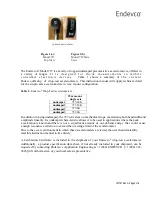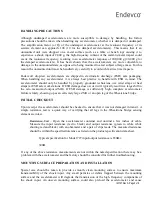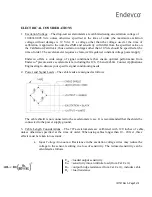
IM727 Rev A, Page 6 of 9
®
If cable lengths longer than 20 feet are required then it is recommended to use a
signal conditioner with an excitation sense (remote sense) feature. In brief, to use
excitation sense a secondary cable (longer) is spliced to the existing accelerometer
cable (shorter). The extension cable has two extra wires; one wire is connected to the
accelerometer’s positive input lead and the other to the accelerometer’s negative input
lead. The two extra wires are used to measure the actual voltage at the accelerometer
and adjust the supplied excitation voltage accordingly until the target value is
achieved. The effect of the voltage drop due to the series resistance in the wires is
eliminated by measuring the voltage using a high input impedance voltmeter.
b.
Signal Attenuation:
Similar to the input voltage attenuation discussion, the resistance
in the output leads will also cause attenuation of the output signal. The reduced
sensitivity is calculated as follows:
E
O
= sensitivity into an infinite load (from Cal. Cert.)
E
OL
= loaded output sensitivity
R
O
= output bridge resistance (from Cal. Cert.), including
cable.
R
L
= load resistance
R
CO
= resistance of the spliced output wire
c.
Cable Capacitance
: Long cable leads act as an RC filter, which can cause significant
attenuation of high frequencies. A rough calculation for the cut-off frequency of such
a filter is as follows:
fc = cut-off frequency, in Hertz (-3 dB)
R = output resistance, in Ohm
C = cable capacitance, in Farad
In general, the above effects are insignificant when cable length is 20 feet (6 meters) or less. The
effects discussed in sections (a) and (b) above are typically accounted for in any factory
calibration, so they must only be considered when longer extension cables are installed by the
customer. Contact Applications Engineering for more information, if required.









